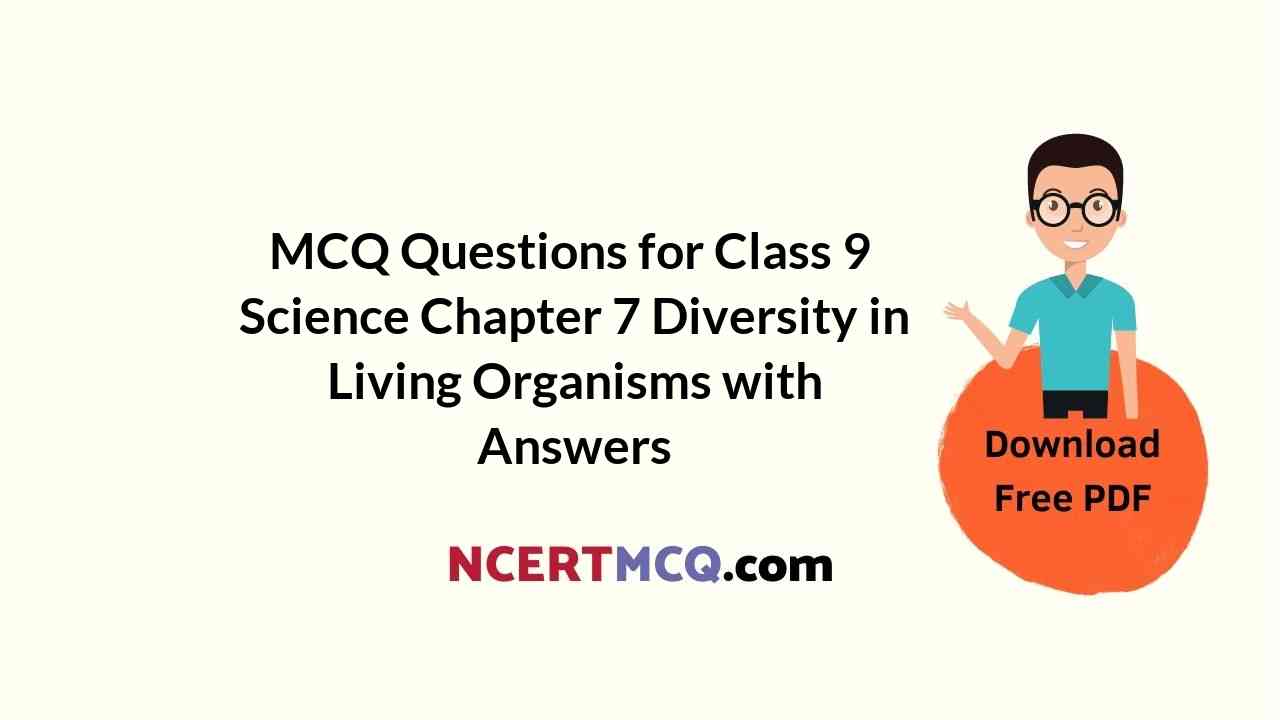Check the below NCERT MCQ Questions for Class 9 Science Chapter 7 Diversity in Living Organisms with Answers Pdf free download. MCQ Questions for Class 9 Science with Answers were prepared based on the latest exam pattern. We have Provided Diversity in Living Organisms Class 9 Science MCQs Questions with Answers to help students understand the concept very well. https://ncertmcq.com/mcq-questions-for-class-9-science-with-answers/
You can refer to NCERT Solutions for Class 9 Science Chapter 7 Diversity in Living Organisms to revise the concepts in the syllabus effectively and improve your chances of securing high marks in your board exams.
Class 9 Science Biology Chapter 7 MCQ With Answers
Biology Class 9 Chapter 7 MCQs On Diversity in Living Organisms
Diversity In Living Organisms Class 9 MCQ Question 1.
Find out incorrect sentence:
(a) Protista includes unicellular eukaryotic organisms
(b) Whittaker considered cell structure, mode and source of nutrition classifying the organisms in five kingdoms
(c) Both Monera and Protista may be autotrophic and heterotrophic
(d) Monerans have well defined nucleus
Answer
Answer: (d) Monerans have well defined nucleus
Class 9 Science Chapter 7 MCQ Question 2.
Which among the following has specialised tissue for conduction of water?
(i) Thallophyta
(ii) Bryophyta
(iii) Pteridophyta
(iv) Gymnosperms
(a) (i) and (ii)
(b) (ii) and (iii)
(c) (iii) and (iv)
(d) (i) and (iv)
Answer
Answer: (c) (iii) and (iv)
Class 9 Science Chapter 7 MCQ With Answers Question 3.
Which among the following produce seeds?
(a) Thallophyta
(b) Bryophyta
(c) Pteridophyta
(d) Gymnosperms
Answer
Answer: (d) Gymnosperms

Diversity In Living Organisms MCQ Question 4.
Which one is a true fish?
(a) Jellyfish
(b) Starfish
(c) Dogfish
(d) Silverfish
Answer
Answer: (c) Dogfish
Class 9 Diversity In Living Organisms MCQ Question 5.
Which among the following is exclusively marine?
(a) Porifera
(b) Echinodermata
(c) Mollusca
(d) Pisces
Answer
Answer: (b) Echinodermata
Class 9 Science Ch 7 MCQ Question 6.
Which among the following have open circulatory system?
(i) Arthropoda
(ii) Mollusca
(iii) Annelida
(iv) Coelenterata
(a) (i) and (ii)
(b) (iii) and (iv)
(c) (i) and (iii)
(d) (ii) and (iv)
Answer
Answer: (a) (i) and (ii)
MCQ On Diversity In Living Organisms Class 9 Question 7.
In which group of animals, coelom is filled with blood?
(a) Arthropoda
(b) Annelida
(c) Nematoda
(d) Echinodermata
Answer
Answer: (a) Arthropoda
Chapter 7 Science Class 9 MCQ Question 8.
Elephantiasis is caused by
(a) Wuchereria
(b) Pinworm
(c) Planarians
(d) Liver flukes
Answer
Answer: (a) Wuchereria
Diversity In Living Organisms Class 9 MCQ Pdf Question 9.
Which one is the most striking or (common) character of the vertebrates?
(a) Presence of notochord
(b) Presence of triploblastic condition
(c) Presence of gill pouches
(d) Presence of coelom
Answer
Answer: (a) Presence of notochord
Diversity In Living Organisms Class 9 MCQ With Answers Question 10.
Which among the following have scales?
(i) Amphibians
(ii) Pisces
(iii) Reptiles
(iv) Mammals
(a) (i) and (iii)
(b) (iii) and (iv)
(c) (ii) and (iii)
(d) (i) and (ii)
Answer
Answer: (c) (ii) and (iii)
Diversity In Living Organisms MCQ Class 9 Question 11.
Find out the false statement.
(a) Aves are warm-blooded, egg laying and have four-chambered heart.
(b) Aves have feather covered body, forelimbs are modified as wing and breathe through lungs.
(c) Most of the mammals are viviparous.
(d) Fishes, amphibians and reptiles are oviparous.
Answer
Answer: (d) Fishes, amphibians and reptiles are oviparous.
MCQ Of Chapter 7 Science Class 9 Question 12.
Pteridophyta do not have
(a) root
(b) stem
(c) flowers
(d) leaves
Answer
Answer: (c) flowers
Class 9 Chapter 7 Science MCQ Question 13.
Identify a member of porifera
(a) Spongilla
(b) Euglena
(c) Penicillium
(d) Hydra
Answer
Answer: (a) Spongilla
MCQ Questions On Diversity In Living Organisms Class 9 Question 14.
Which is not an aquatic animal?
(a) Hydra
(b) Jelly fish
(c) Corals
(d) Filaria
Answer
Answer: (d) Filaria
MCQ Questions For Class 9 Science Chapter 7 Question 15.
Amphibians do not have the following
(a) Three-chambered heart
(b) Gills of lungs
(c) Scales
(d) Mucus glands
Answer
Answer: (c) Scales
Question 16.
Organisms without nucleus and cell organelles belong to
(i) fungi
(ii) protista
(iii) cyano bacteria
(iv) archae bacteria
(a) (i) and (ii)
(b) (iii) and (iv)
(c) (i) and (iv)
(d) (ii) and (iii)
Answer
Answer: (b) (iii) and (iv)
Question 17.
Which of the following is not a criterion for classification of living organisms?
(a) Body design of the organism
(b) Ability to produce one’s own food
(c) Membrane bound nucleus and cell organelles
(d) Height of the plant
Answer
Answer: (d) Height of the plant
Question 18.
The feature that is not a characteristic of protochordata?
(a) Presence of notochord
(b) Bilateral symmetry and coelom
(c) Jointed legs
(d) Presence of circulatory system
Answer
Answer: (c) Jointed legs
Question 19.
The locomotory organs of Echinodermata are
(a) tube feet
(b) muscular feet
(c) jointed legs
(d) parapodia
Answer
Answer: (a) tube feet
Question 20.
Corals are
(a) Poriferans attached to some solid support
(b) Cnidarians, that are solitary living
(c) Poriferans present at the sea bed
(d) Cnidarians that live in colonies
Answer
Answer: (d) Cnidarians that live in colonies
Question 21.
Who introduced the sytem of scientific nomenclature of organisms?
(a) Robert Whittaker
(b) Carolus Linnaeus
(c) Robert Hooke
(d) Ernst Haeckel
Answer
Answer: (b) Carolus Linnaeus
Question 22.
Two chambered heart occurs in
(a) crocodiles
(b) fish
(c) aves
(d) amphibians
Answer
Answer: (b) fish
Question 23.
Skeleton is made entirely of cartilage in
(a) Sharks
(b) Tuna
(c) Rohu
(d) None of these
Answer
Answer: (a) Sharks
Question 24.
One of the following is not an Annelid?
(a) Nereis
(b) Earthworm
(c) Leech
(d) Urchins
Answer
Answer: (d) Urchins
Question 25.
The book Systema Naturae was written by
(a) Linnaeus
(b) Haeckel
(c) Whittaker
(d) Robert Brown
Answer
Answer: (a) Linnaeus
Question 26.
Karl Von Linne was involved with which branch of science?
(a) Morphology
(b) Taxonomy
(c) Physiology
(d) Medicine
Answer
Answer: (b) Taxonomy
Question 27.
Real organs are absent in
(a) Mollusca
(b) Coelenterata
(c) Arthropoda
(d) Echinodermata
Answer
Answer: (b) Coelenterata
Question 28.
Hard calcium carbonate structures are used as skeleton by
(a) Echinodermata
(b) Protochordata
(c) Arthropoda
(d) Nematoda
Answer
Answer: (a) Echinodermata
Question 29.
Differentiation in segmental fashion occurs in
(a) Leech
(b) Starfish
(c) Snails
(d) Ascaris
Answer
Answer: (a) Leech
Question 30.
In taxonomic hierarchy family comes between
(a) Class and Order
(b) Order and Genus
(c) Genus and Species
(d) Division and Class
Answer
Answer: (b) Order and Genus
Question 31.
5-Kingdom classification has given by
(a) Morgan
(b) R. Whittaker
(c) Linnaeus
(d) Haeckel
Answer
Answer: (b) R. Whittaker
Question 32.
Well defined nucleus is absent in
(a) blue green algae
(b) diatoms
(b) algae
(d) yeast
Answer
Answer: (a) blue green algae
Question 33.
The ‘Origin of Species’ is written by
(a) Linnaeus
(b) Darwin
(c) Hackel
(d) Whittaker
Answer
Answer: (b) Darwin

Question 34.
Meena and Han observed an animal in their garden. Hari called it an insect while Meena said it was an
earthworm. Choose the character from the owing which confirms that it is an insect.
(a) Bilateral symmetrical body
(b) Body with jointed legs
(c) Cylindrical body
(d) Body with little segmentation
Answer
Answer: (b) Body with jointed legs
Write true (T) or false (F)
1. Whittaker proposed five kingdom classification.
Answer
Answer: True
2. Monera is divided into Archaebacteria and Eubacteria.
Answer
Answer: True
3. Starting from Class, Species comes before the Genus.
Answer
Answer: False
4. Anabaena belongs to the kingdom Monera.
Answer
Answer: True
5. Blue-green algae belongs to the kingdom Protista.
Answer
Answer: False
6. All prokaryotes are classified under Monera.
Answer
Answer: True
Fill in the blanks
1. The naming of organisms is done according to ……………. nomenclature proposed by Carolus Linnaeus.
Answer
Answer: binomial
2. The phylum …………… consists of organisms which have a pseudocoelom.
Answer
Answer: nematoda
3. The spiny skinned organisms belong to phylum …………….
Answer
Answer: echinodermata
4. The presence of hollow and light bones is a characteristic feature of class ……………
Answer
Answer: aves
5. The unicellular eukaryotes are kept in Kingdom ……………..
Answer
Answer: Protista
6. The phylum ………….. is the second largest phylum of the kingdom Animalia.
Answer
Answer: mollusca
7. The protist which lacks cell wall and can have autotrophic as well as heterotrophic mode of nutrition is ……………
Answer
Answer: algae
8. Presence of dry scales on their body is a characteristic feature of class ……………
Answer
Answer: pisces
9. The presence of internal metameric segmentation as well as external segmentation is a feature of phylum …………….
Answer
Answer: annelida
10. The vascular cryptogams are the members of the group called ……………….
Answer
Answer: pteridophytes
Match the following
| Column A | Column B |
| (a) Coelom | (i) Monera |
| (b) Taxonomy | (ii) Echinodermata |
| (c) Pseudocoelom | (iii) Arthropoda |
| (d) Pneumatic bones | (iv) Body cavity |
| (e) Notochord in entire length of body | (v) Protista |
| (f) Unicellular prokaryote | (vi) Protochordata |
| (g) Jointed legs | (vii) Carolus Linnaeus |
| (h) Water vascular system | (viii) Aves |
| (i) Unicellular eukaryote | (ix) Nematoda |
Answer
Answer:
| Column A | Column B |
| (a) Coelom | (iv) Body cavity |
| (b) Taxonomy | (vii) Carolus Linnaeus |
| (c) Pseudocoelom | (ix) Nematoda |
| (d) Pneumatic bones | (viii) Aves |
| (e) Notochord in entire length of body | (vi) Protochordata |
| (f) Unicellular prokaryote | (i) Monera |
| (g) Jointed legs | (iii) Arthropoda |
| (h) Water vascular system | (ii) Echinodermata |
| (i) Unicellular eukaryote | (v) Protista |
We hope the given NCERT MCQ Questions for Class 9 Science Chapter 7 Diversity in Living Organisms with Answers Pdf free download will help you. If you have any queries regarding Diversity in Living Organisms CBSE Class 9 Science MCQs Multiple Choice Questions with Answers, drop a comment below and we will get back to you soon.
Class 9 Science Biology MCQ:
